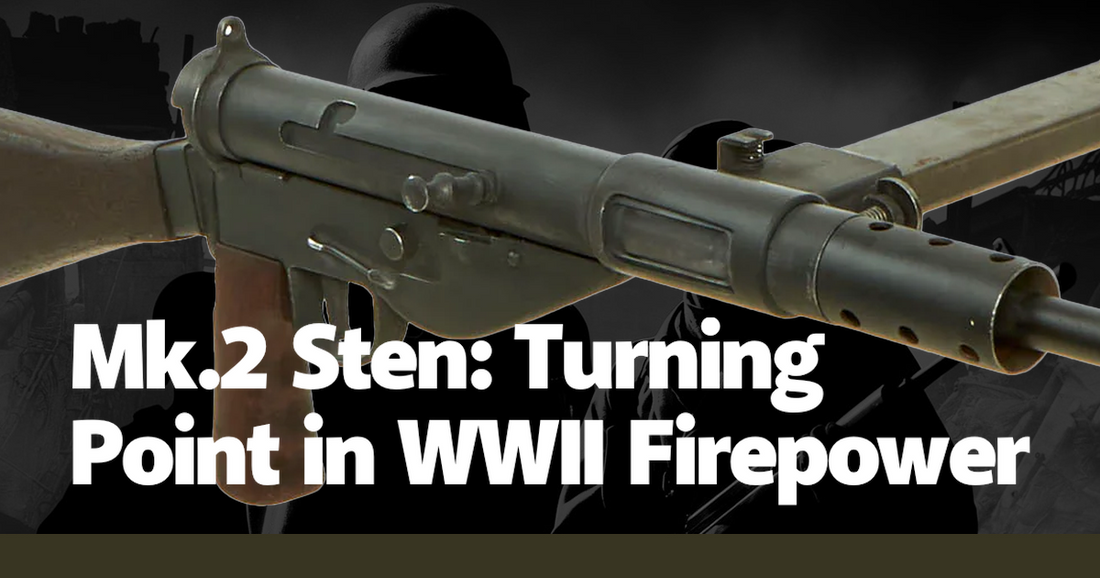In the annals of World War II history, the Mk.2 Sten submachine gun stands as a symbol of ingenuity and resilience. This unassuming firearm, often overshadowed by more famous weapons like the M1 Garand or the Thompson submachine gun, played a pivotal role in shifting the dynamics of infantry warfare. Born out of necessity during the dark days of 1940, when Britain faced the imminent threat of Nazi invasion, the Mk.2 Sten was a testament to the ingenuity of British engineering. Its creation was driven by the dire need for a simple, cost-effective, and easily mass-produced weapon that could arm the vast numbers of soldiers and resistance fighters across occupied Europe.
The Mk.2 Sten's design was revolutionary in its simplicity. Comprised of just 47 parts, it could be produced quickly and cheaply, a crucial factor during a time when materials and skilled labor were in short supply. The gun's utilitarian design featured a side-mounted magazine, a basic tubular receiver, and a fixed firing pin, which allowed for rapid production. This simplicity did not come without its drawbacks, as the Sten was notorious for jamming and accidental discharges. However, its ease of manufacture and the ability to produce it in large numbers outweighed these issues, making it an invaluable asset for the Allied forces.
One of the most compelling aspects of the Mk.2 Sten was its role in the hands of resistance fighters across Europe. The gun's compact size and light weight made it ideal for guerrilla warfare, allowing partisans to strike swiftly and disappear into the shadows. Stories abound of French, Yugoslav, and Polish resistance fighters using the Sten to great effect against German occupiers. The weapon became a symbol of defiance and hope, enabling ordinary citizens to take up arms and fight for their freedom. The Sten's presence in these resistance movements was a significant factor in the success of numerous sabotage operations and ambushes that disrupted German supply lines and communications.
The Sten also saw extensive use by British and Commonwealth forces, particularly in the hands of paratroopers and commandos. Its compact design made it ideal for airborne operations, where space and weight were at a premium. During the D-Day landings, British paratroopers armed with Stens played a crucial role in securing key objectives behind enemy lines. The gun's simplicity and reliability in close-quarters combat made it a favorite among these elite troops. Anecdotes from veterans often highlight the Sten's effectiveness in the brutal, chaotic battles that characterized the Normandy campaign, where its rapid rate of fire and ease of use provided a significant advantage.
Despite its utilitarian appearance, the Mk.2 Sten was a remarkably versatile weapon. It could be easily modified with suppressors for covert operations, and its design allowed for various attachments and customizations. This adaptability made it a favorite among special operations units, who valued the ability to tailor their weapons to specific missions. The Sten's role in clandestine operations, such as the assassination of high-ranking German officers and the sabotage of critical infrastructure, further cemented its reputation as a weapon of choice for unconventional warfare.
The psychological impact of the Mk.2 Sten on both Allied and Axis forces cannot be overstated. For the Allies, the Sten represented a lifeline, a means to fight back against overwhelming odds. For the Germans, the proliferation of Stens among resistance fighters and Allied troops was a constant source of anxiety. The gun's distinctive appearance and sound became synonymous with the ever-present threat of ambush and sabotage. This psychological warfare aspect added an extra layer of effectiveness to the Sten, making it not just a tool of war, but a symbol of resistance and resilience.
In the broader context of World War II firepower, the Mk.2 Sten marked a turning point in the democratization of military technology. It demonstrated that effective weaponry did not have to be expensive or complex. The Sten's success paved the way for future developments in small arms, influencing post-war designs and the approach to mass production of military hardware. Its legacy can be seen in the proliferation of simple, reliable firearms that have armed soldiers and insurgents alike in conflicts around the world.
The Mk.2 Sten's impact on World War II and its enduring legacy in military history cannot be overstated. It was a weapon born out of desperation, yet it became a symbol of hope and defiance. Its simplicity, versatility, and effectiveness in the hands of both regular troops and resistance fighters made it a crucial element in the Allied victory. The stories of bravery and ingenuity associated with the Sten continue to inspire, reminding us that sometimes, the most unassuming tools can make the most significant difference.

